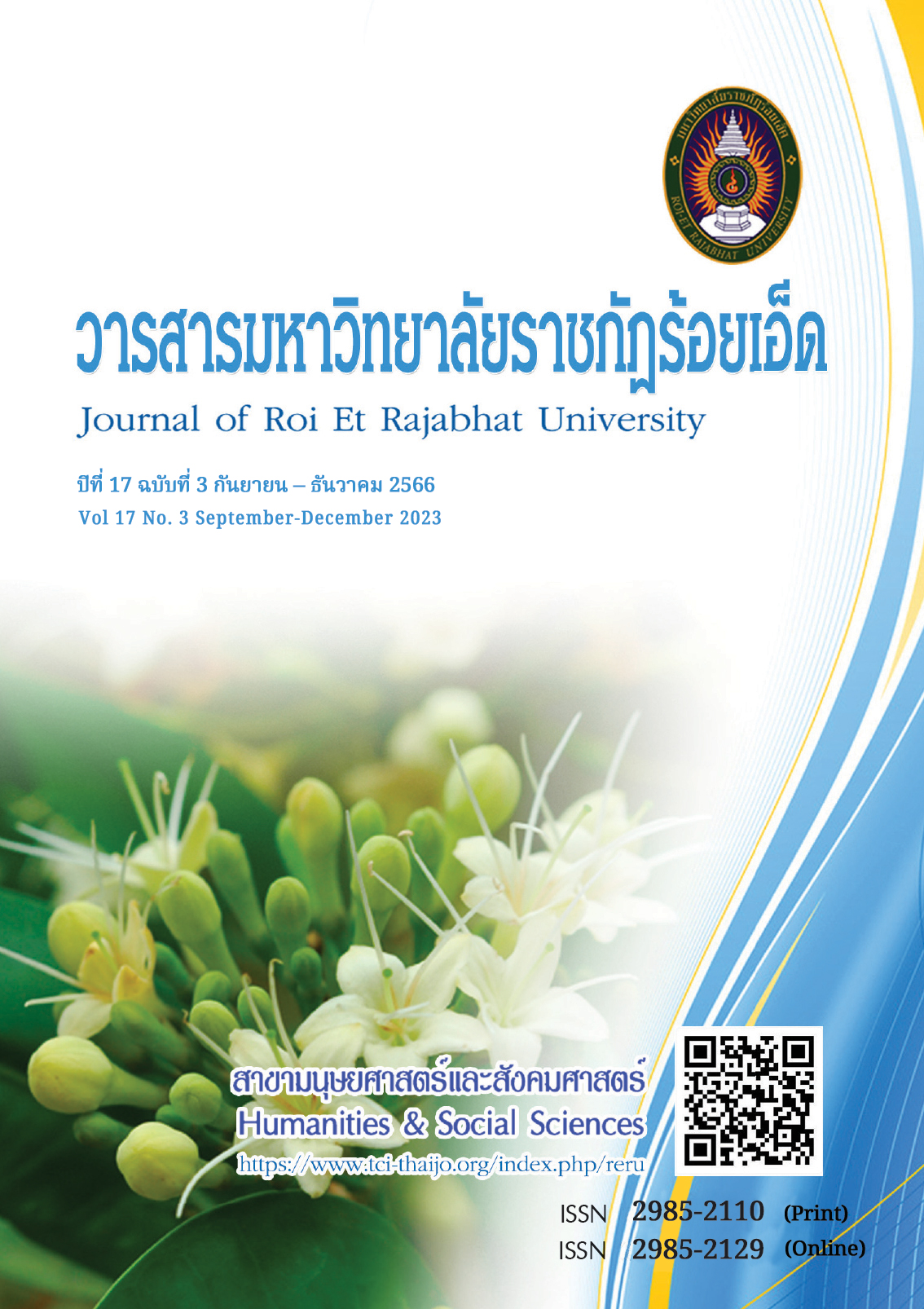Factors affecting the Creative Leadership of Students in the Faculty of Education, Thailand National Sports University, Chon Buri Campus
Keywords:
Leadership, Creative Leadership, Students in the Faculty of EducationAbstract
The purposes of this research were to study correlation and create equations to predict the creative leadership of students in the Faculty of Education, Thailand National Sports University, Chon Buri Campus. The samples consisted of 200 students were selected using stratified random sampling from students at the Faculty of Education, Thailand National Sport University, Chon Buri Campus in academic years 2022. The research instrument was a rating-scale questionnaire (IOC=0.60-1.00, α = 0.89). The data were then analyzed in terms of Stepwise Multiple Regression Analysis.
The research results found that 1) the factors learning management, creative thinking and creative leadership were at a high level. While student development activities, open learning environment and motivation were at a moderate level. 2) All factors had a positive correlation with creative leadership with statistical significance at the level of .01. 3) Indicated that the factors that could predict the creative leadership of students in the faculty of education, Thailand National Sports University, Chon Buri Campus with statistical significance at the level of .01 comprised these 3 factors arranged from the most impactful factors to
the least.: creative thinking (X4); student development activities (X2); and open learning environment (X3). These 3 factors could predict the creative leadership efficiency with a percentage of 74.50. The significantly predicted equations were as follows:
In term of raw scores were:
Y/ = -0.283 + 0.426(X4) + 0.356(X2) + 0.317(X3)
In term of standard scores were:
Z/Y = 0.399(Z X 4) + 0.327(ZX 2 + 0.282(ZX3
References
กระทรวงศึกษาธิการ. (2564, 18 พฤศจิกายน). ประกาศคณะกรรมการคุรุสภา เรื่อง หลักเกณฑ์และวิธีการทดสอบและประเมินสมรรถนะทางวิชาชีพครู (ฉบับที่ 2) พ.ศ. 2564. ราชกิจจานุเบกษา. เล่ม 138 ตอนพิเศษ 283ง หน้า 19.
กัญญา สายลอด สุวรรณา โชติสุกานต์ และอรสา จรูญธรรม. (2564). ภาวะผู้นำเชิงสร้างสรรค์ของผู้บริหารและพฤติกรรมการเป็นสมาชิกที่ดีขององค์กรของครู สังกัดสำนักงานเขตพื้นที่การศึกษาประถมศึกษาปทุมธานี. วารสาร มจร บาฬีศึกษาพุทธโฆสปริทรรศน์. 7(20), 163-176.
กิตติ์กาญจน์ ปฏิพันธ์. (2555). โมเดลสมการโครงสร้างภาวะผู้นำเชิงสร้างสรรค์ของผู้บริหารสถานศึกษาอาชีวศึกษา.ดุษฎีนิพนธ์ ปรัชญาดุษฎีบัณฑิต สาขาวิชาการบริหารการศึกษา. ขอนแก่น: มหาวิทยาลัยขอนแก่น.
กิตติ์กาญจน์ ปฏิพันธ์, จักรกฤษณ์ โพดาพล และวิลัยพรณ์ เสรีวัฒน์. (2556). ภาวะผู้นำเชิงสร้างสรรค์ : สิ่งที่ควรค่าสำหรับทุกคนในอนาคต. ขอนแก่น: คลังนานาวิทยา.
คติพงษ์ อ่อนไชย, สถิรพร เชาวน์ชัย และ วิทยา จันทร์ศิลา. (2565). แนวทางการพัฒนาภาวะผู้นำเชิงสร้างสรรค์ของผู้บริหารสถานศึกษา ในอาชีวศึกษาจังหวัดพิจิตร สังกัดสำนักงานคณะกรรมการการอาชีวศึกษา. Journal of Modern Learning Development. 7(2), 65-76.
ธเนศ ศรพรหม. (2563). การศึกษาผลการใช้รูปแบบการเรียนรู้ที่ส่งเสริมความคิดสร้างสรรค์ ภายใต้สภาพแวดล้อมแบบเปิด สำหรับนักศึกษาปริญญาตรี. วารสารศึกษาศาสตร์ มหาวิทยาลัยมหาสารคาม. 14(2), 74-87.
ปิยวรรณ รามศิริ ทัศนา แสวงศักดิ และสมชาย เทพแสง. (2561). การพัฒนารูปแบบภาวะผู้นําเชิงสร้างสรรค์ของผู้บริหารสถานศึกษาสังกัดองค์กรปกครองส่วนท้องถิ่น. วารสารบริหารการศึกษา มหาวิทยาลัยศรีนครินทรวิโรฒ. 15(28), 12-25.
ภัทรพล เสริมทรง และธนวัฒน์ ชาวโพธิ์. (2564). ภาวะผู้นำเชิงสร้างสรรค์ของนักศึกษาหลักสูตรรัฐศาสตรบัณฑิต สาขาวิชาการปกครองภาคนอกเวลาราชการ (เสาร์ - อาทิตย์) มหาวิทยาลัยมหามกุฏราชวิทยาลัย วิทยาเขตศรีล้านช้าง. วารสารสังคมศาสตร์บูรณาการ. 1(1), 49-56.
วิวัฒน์ มีสุวรรณ. (2563). ปัจจัยที่ส่งผลต่อการสร้างสรรค์นวัตกรรมด้านสื่อการเรียนการสอนของครูในสถานศึกษาสำหรับปฏิบัติการสอน เครือข่ายมหาวิทยาลัยนเรศวร. วารสารศึกษาศาสตร์ มหาวิทยาลัยนเรศวร. 22(1), 220-236.
วรกฤต ศิรธนิตรา. (2563). การพัฒนาภาวะผู้นำเชิงสร้างสรรค์ของผู้บริหารสถานศึกษาในเขตภาคตะวันออกเฉียงเหนือตอนล่าง. วารสารวิชาการมหาวิทยาลัยการจัดการและเทคโนโลยีอีสเทิร์น. 17(1), 69-79.
สใบแพร สัพสือภิสิทธิ์ สมศรีสุข และวาโร เพ็งสวัสดิ์. (2562). การพัฒนาตัวบ่งชี้ภาวะผู้นําเชิงสร้างสรรค์ของผู้บริหารโรงเรียนประถมศึกษาสังกัดสำนักงานเขตพื้นที่การศึกษาประถมศึกษาในจังหวัดสกลนคร.วารสารมหาวิทยาลัยราชภัฏร้อยเอ็ด 13(3), 37-45.
สมชาย รุ่งเรือง และธีระวัฒน์ จันทึก. (2560). รูปแบบการพัฒนาผู้นำสู่การสร้างแรงผลักดันเชิงสร้างสรรค์. Veridian E-Journal,Silpakorn University 10(1), 29-46.
สำเร็จ คำโมง. (2565). ปัจจัยที่มีอิทธิพลต่อภาวะผู้นำเชิงสร้างสรรค์ของผู้บริหารสถานศึกษา สังกัดสำนักงานคณะกรรมการส่งเสริมการศึกษาเอกชน จังหวัดขอนแก่น. วารสารพุทธปรัชญาวิวัฒน์. 6(2), 518-528.
Blaskova, M., & Trskova, K. (2017). Creative leadership and motivation of university employees. New Trends and Issues Proceedings on Humanities and Social Sciences, 4, 23-34.
Hair, Jr., J. F., Black, W. C., Babin, B. J., Anderson, R. E. & Black, R. L., W.C. (2018). Multivariate Data Analysis (8th ed.). Upper Saddle River, NJ: Pearson Prentice Hall.
Harris, A. (2009). Creative leadership. Journal of Management in Education, 23(1), 9-11.
Sohmen, V. S. (2015). Reflections on creative leadership. International Journal of Global Business, 8(1),1-14.
Sukdee, T. (2021). The development of indicators for transformational leadership of
Undergraduate students at Thailand national sports university. World Journal of
Education, 11(1), 94-106. doi:10.5430/wje.v11n1p94.
Downloads
Published
How to Cite
Issue
Section
License
Copyright (c) 2023 Roi Et Rajabhat University

This work is licensed under a Creative Commons Attribution-NonCommercial-NoDerivatives 4.0 International License.
บทความที่ได้รับการตีพิมพ์เป็นลิขสิทธิ์ของวารสารมหาวิทยาลัยราชภัฎร้อยเอ็ด
ข้อความที่ปรากฏในบทความแต่ละเรื่องในวารสารวิชาการเล่มนี้เป็นความคิดเห็นส่วนตัวของผู้เขียนแต่ละท่านไม่เกี่ยวข้องกับมหาวิทยาลัยราชภัฎร้อยเอ็ด และคณาจารย์ท่านอื่นๆในมหาวิทยาลัยฯ แต่อย่างใด ความรับผิดชอบองค์ประกอบทั้งหมดของบทความแต่ละเรื่องเป็นของผู้เขียนแต่ละท่าน หากมีความผิดพลาดใดๆ ผู้เขียนแต่ละท่านจะรับผิดชอบบทความของตนเองแต่ผู้เดียว





